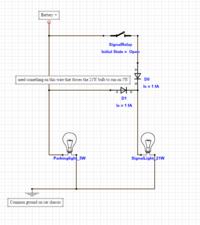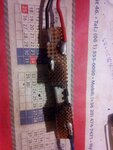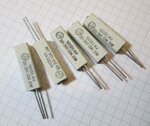DPluss
Junior Member level 2
Hey All!
I'm a real beginner in electronics but as a car mechanic I face it every day.
Let me explain my problem, I have a small circuit which I bought on the internet and I would like to replicate it since it kinda melted over the year I used it!
This little "device" connects the 5W parking light of my car to the 21W signal light so it works like a side-marker in the US, when my 5W parking light is on, my indicator light is illuminated with 5W aswell which is not so bright but its because when I use my signal light it gets its full 21W.
I figured out that it uses 2 diodes, 1 for the + of the parking light so it doesnt signal when using the signal, and one for the + of the signal to prevent the parking light from turning on the signal light on the back of the car. What I dont know is how do I make a 21W bulb to work on 5W?
The circuit would look like this if I exlude the thing that converts the 21W to 5W:

I'm a real beginner in electronics but as a car mechanic I face it every day.
Let me explain my problem, I have a small circuit which I bought on the internet and I would like to replicate it since it kinda melted over the year I used it!
This little "device" connects the 5W parking light of my car to the 21W signal light so it works like a side-marker in the US, when my 5W parking light is on, my indicator light is illuminated with 5W aswell which is not so bright but its because when I use my signal light it gets its full 21W.
I figured out that it uses 2 diodes, 1 for the + of the parking light so it doesnt signal when using the signal, and one for the + of the signal to prevent the parking light from turning on the signal light on the back of the car. What I dont know is how do I make a 21W bulb to work on 5W?
The circuit would look like this if I exlude the thing that converts the 21W to 5W:

Last edited by a moderator:

